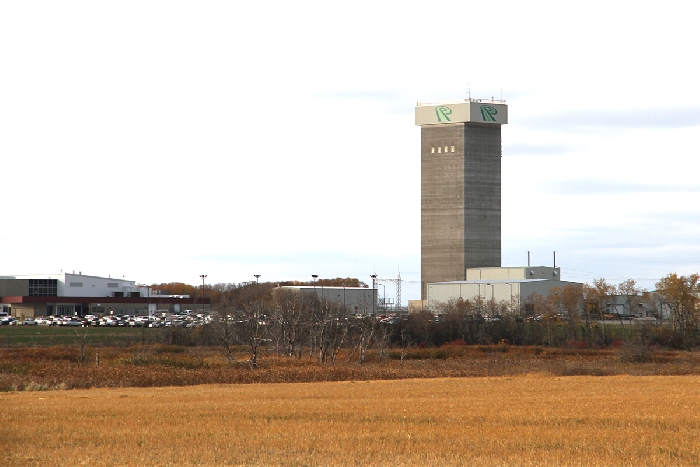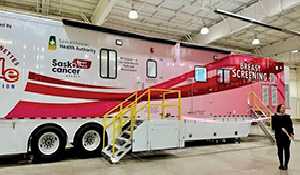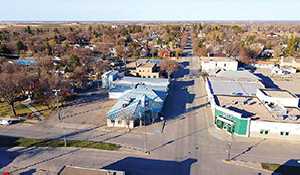PotashCorp Rocanville the biggest potash mine in the world
October 22, 2017, 3:20 am
Kara Kinna


PotashCorp celebrated the successful completion of its Rocanville mine expansion with an event at the Scissors Creek mine site near Rocanville Thursday.
The mine is located just north of Rocanville, and about 20 miles north of Moosomin.
The company’s largest potash expansion—which took nine years from announcement to completion—has more than doubled the mine’s capacity, from 3.0 million tonnes annually to 6.5 million tonnes.
According to PotashCorp, Rocanville is the company’s lowest cost mine and a key part of the company’s future.
The centerpiece of the $3 billion expansion is the first new potash shaft built in Saskatchewan in nearly 40 years.
The new shaft, sunk 1,123 metres into the ground, is dedicated to moving people and materials into and out of the mine.
The old service shaft was converted to a second production shaft, allowing for expanded production.
The project also included construction of a new mill, a new 500,000 tonne storage facility (the size of several football fields), a new office building and a range of other infrastructure elements.
The footprint of the PotashCorp Rocanville mine, including the underground mining area, is now approximately the same size as the city of Saskatoon.
“We’re now officially the largest potash mine in the world, with our official Canpotex number being 6.51 million tonnes,” PotashCorp Rocanville General Manager Larry Long told a large crowd of people gathered at the Scissors Creek site to celebrate the completion of the expansion Thursday, Oct. 12.
“My career hasn’t always been in the potash industry, I’ve also worked in the hard rock industry and I’m pretty sure we’re not only the largest potash mines in the world, but I think we’re probably one of the largest rock moving operations in the world, period. So it’s something we all can be proud about, all the people involved in getting us to this point—our employees, everyone.”
PotashCorp President and CEO Jochen Tilk spoke at the celebration. He said the PotashCorp expansion is an incredible accomplishment in more ways than one.
“This is a significant achievement for our company. It’s a significant achievement for all of us,” said Tilk.
“I joined this company over three years ago . . . To be here today and celebrate with you all together the achievement of building a brand new mine, an expansion, the shaft with all the metrics that are so impressive, makes me very, very proud. I think it’s an incredible accomplishment.
“Next month we will mark 10 years since the three billion dollar Rocanville expansion project was first announced. Ten years ago this, where we sit here today, was an open field. But we knew that below this ground there was a lot of potash that we could mine economically. So this decision was based on a tremendous vision.
“We began excavation in 2010 and we broke through the underground mine workings in 2015.
“That makes Scissors Creek the first new shaft that was sunk in the province of Saskatchewan for nearly 40 years. The last shaft that was sunk prior to that was 1979 and that was the Lanigan shaft.
“Imagine what that means for the expertise. People don’t sit around for 40 years and say ‘give me a call when you sink a shaft.’ It is an expertise that is so challenging, so unique, and there were challenges along the way, quite a few. There were numerous water bearing formations that we had to get through that we knew about. It was a very complex project that required a lot of technical expertise. So completing the new shaft was a great accomplishment for our employees and our contractors who helped us.
“The project also included a new storage building, with 500,000 tonnes of capacity, new rail infrastructure, and new loadout capacity, and a new underground conveyor system to move the potash from the ore body to a production facility.
“We installed enough conveyor belt underground to run from Rocanville to Yorkton. So when you make that drive, imagine that next to that road would be a conveyor belt all the way.
“We also completed a new headframe, the world’s tallest steel headframe and one of the tallest structures in Saskatchewan.
“These are all impressive comparisons, but it’s a reflection of all the work that you have done and that you have participated in.
“While that was underway we were also building a new mill to accommodate expanded production capacity. That new mill now has the capacity of 1,300 tonnes. And the old mill has the capacity of 1,100 tonnes per hour, which means together approximately 2,400 tonnes per hour. Put that in your mind, 2,400 tonnes of potash that comes out of those two mills, how many trucks that is, how many trainloads per hour. It’s phenomenal.
“Our motto is that we help nature provide, we feed the world because we provide one of the most important nutrients, and if Rocanville is number one in the world as a potash producer, then by extension we are number one in feeding the world with this most important nutrient.
“So with the two mills now we have one great flexibility which means we can now perform maintenance on one of them while continuing to produce with the other one. And that ability to continue operating through shutdowns is an added flexibility that Rocanville now has, which will make it even more productive.
“Given the sheer size and scope of the project, there were times when 1,800 contractors were on site. Not only were all of these structures built, but it was done safely. In spite of the large number of people and the wide range of construction activities that were underway at any given time, the expansion was done without incurring any serious injury or fatality. That to me is the major accomplishment of this, that we have done all of this without harming one person.
“Arriving at where we are today, it’s not just a huge milestone but it’s an incredible milestone for PotashCorp and all of our partners. We remain globally competitive. We are more efficient because now overall our costs are lower and we have been able to optimize our outputs with high quality, easy to access ore.
“Results speak for themselves. We have reduced our cash costs, from $136 per tonne in 2013 to $86 a tonne in the first half of this year. That is unbelievable if you think about it, not quite half but close.
“That helps us to position ourselves very successfully in difficult market conditions. And even though market conditions have improved, we have improved our position in a very competitive market.
“We also have the flexibility to meet the increasing needs of our customers. This year we realized that momentum was there in the market, we noticed that demand was increasing.
“For the reasons we see demand picking up, we have every reason to be optimistic about the future. Global demand is growing at about 2.5 to 3 per cent a year and we estimate that demand will be 62 to 65 million tonnes, reaching an all time high.
“Think about that—2.5 per cent of 65 million is about 1.5 million tonnes a year. That’s a lot of volume. And people tend to forget that.
“And you of anyone know how hard it is to just produce another million tonnes a year. If it were easy everyone would do it. However we are set up for that, we can meet that demand and I think that’s planning for the future and that’s where the potential is here.
“We’re grateful for the men women who have worked so hard on the expansion.
“I want to finish by saying what a bright future we have. This has been a good year for us. This is a great moment to celebrate it and I think next year will be an even better year.”
PCS Potash President Mark Fracchia also spoke at the celebration.
“It has been a ten-year journey, and every journey has to start with the first step, and for us that first step was the announcement of the expansion pretty much ten years ago. And ten years goes by very, very quickly when you have as much activity on a site as we have here. So this has been a long journey, and I’m sure I share this feeling with everybody involved that it has gone by extremely fast.
“I think most of us ten years ago would have looked at this day thinking it may never come, and it came much sooner then anybody felt it would.
“We are glad to be here, we are glad to get to that part of that journey and go on with optimizing this operation. That single event, that announcement of the expansion, set in motion a number of events that have had an extremely positive impact not only for Rocanville but for the communities.
“When you think about the infusion of people, the jobs, the economic activity in the area, especially around that period of 2008, 2009, 2010 where things slowed down because of an economic downturn, the activity never slowed down here, it just kept on going. That is something we are feeling today, all of the result from that additional economic activity.”
Fracchia said there were 1,800 contractors working on site at any given time.
“The project took about 4.5 million person hours to complete and during that period we had a lost time frequency over the entire project of .17 for 200,000 hours worked, which is really class leading for any construction project let alone a project this size,” he said. “And the best part of that, we had no life threatening or life altering injuries during that period which is really something, that is a testament to the effort that everybody put in each and every day. So for us that is really what made the project a success. That was the icing on the cake, and if it weren’t for that I don’t think we would be talking about the project in the same way.”
Fracchia said he is also proud of the expertise that went into the project.
“The fact that we hadn’t sunk a shaft in Saskatchewan since 1979 meant that the expertise was essentially gone. Most of the people who were involved in sinking mine shafts for potash were either retired or deceased unfortunately, so that expertise had left,” he said. “To a large extent our teams had to relearn that expertise, relearn that knowledge along the way as we were sinking the Scissors Creek shaft. And the shaft itself of course is sunk to the depth of 1,100 metres, which to put in perspective is not only over a kilometer in depth—most have you have seen the CN Tower, it is about 1,800 ft in height—and it is about twice that distance, but into the ground. So you can appreciate that it takes quite a bit of effort it. Is a complex task to make that happen.”
Fracchia said the other challenge was tunnelling over to the shaft from the Rocanville site.
“We decided to tunnel from the west end of our mine. We had a distance of about 13 km, tunnelling two parallel rooms toward that mine shaft. The first challenge is to make sure we are going in the right direction. And when we got there the next challenge was to line across to connect these two parallel rooms, and to do so right underneath where the shaft was being sunk.
“In a mining environment we don’t have the benefit of GPS, we can’t look on Google maps and get us to the right place. Our technical teams used a seismic method developed by the University of Saskatchewan to essentially triangulate that distance, that location by listening to the blasts from the shaft sinking operation and pinpointing where that signal was coming from so that we could mine right underneath the shaft.
“Believe me it’s a very complicated process and we were so relieved when we hit the bullseye, we essentially mined right up to that point and our accuracy was 1.8 feet away from where we predicted.
“While all of this underground work was occurring there was a lot of work going on above ground. We converted our old service headframe to a production headframe, but the key thing is that we did so over and around and above the existing headframe. We installed a new hoist and then when it was all sent during the shutdown period. We moved the old headframe from underneath and just connected the shaft to the new headframe. And that was something that hadn’t been done before. It’s unique, it’s a first in the mining industry and we did it right here.”
Fracchia said the effects of the expansion will be long-term.
“With the expansion completed our workforce here in Rocanville has grown. In fact it’s doubled. It’s up to over 750 people and that’s about the level we expected to be at going forward.
“Looking ahead we know the effects go beyond our minesite. This workforce means more people in the community, more jobs, more young families moving into our towns. It means continued enrollment in our schools and more money spent locally which is good for everybody in the area.
“At PotashCorp we are very grateful for the strong partnerships we have with our employees, our contractors and with our communities and we certainly don’t ever want to take that for granted and we certainly don’t. We know it’s important to be a good neighbor, we know we can make a difference and we strive to make that difference, whether it’s just creating in good stable jobs or investing in projects that enrich our communities and making them better places to live and we think we are doing that in Rocanville and surrounding areas.
“Today we recognize the hard work and skill that everyone has put in in getting us to this point, and it couldn’t happen without all of you so a big thanks to all of you.”
PotashCorp Rocanville expansion facts
• 6.5 million tonnes nameplate capacity following the expansion
• Rocanville is expected to deliver approximately half of PotashCorp’s production in 2017
• Mill capacity is more than double pre-expansion level
• More than double the number of employees pre-expansion
• Headframe is 350 feet, one of the tallest structures in Saskatchewan
• 3685 feet is the depth of new service shaft
• 184 is the number of Blairmore rings used in construction of the new mineshaft
• 500,000 tonnes is the new warehouse storage capacity
• There are 300 km of electrical cable running through the new facility
• There are 130 km of conveyor belts installed underground



































